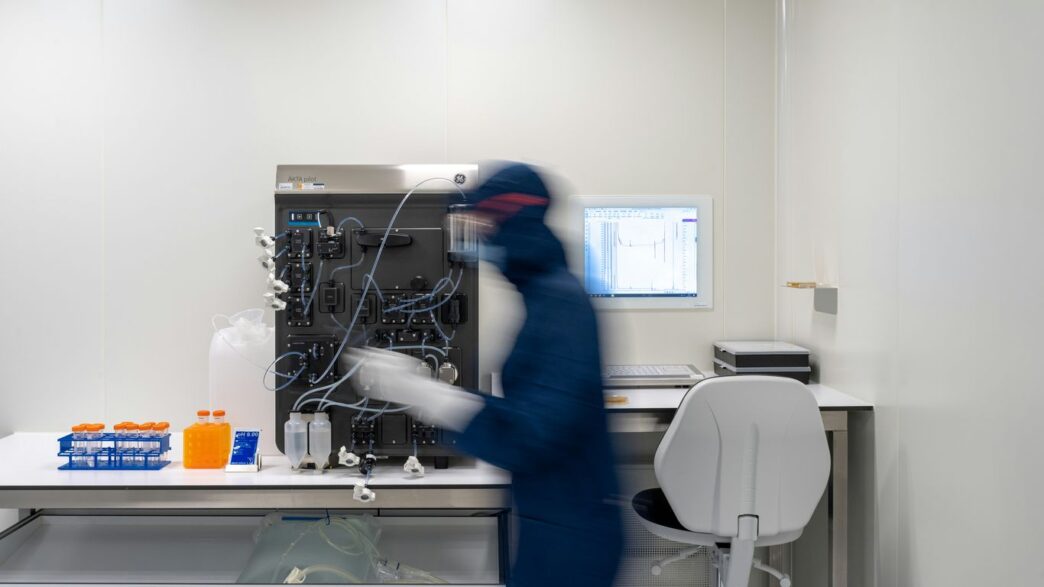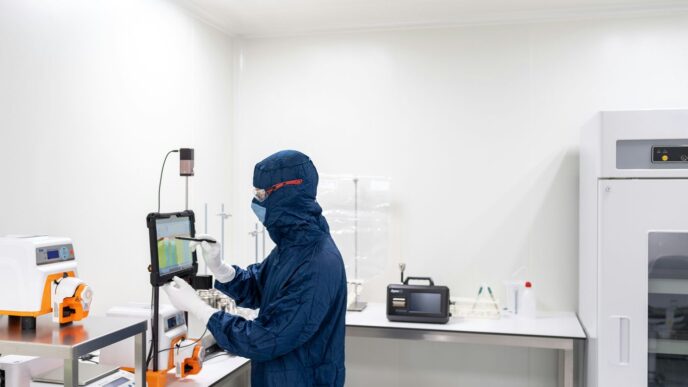The European biotech scene has been through a lot lately, from big funding surges to more careful spending. It’s not quite the wild west of a few years ago, but that doesn’t mean innovation has stopped. In fact, it feels like things are getting smarter. Companies are focusing on what really works, investors are being more selective, and some regions are really stepping up. This article looks at what’s happening with leading european biotech companies in 2025, focusing on where the money is going, what’s new in science, and which places are becoming hot spots.
Key Takeaways
- The funding for european biotech companies has gone through distinct phases: a rapid increase during the pandemic, a market correction, and now a more selective recovery where investors focus on solid science and clear plans.
- New technologies like AI and advanced cell therapies are getting a lot of attention, but established areas like antibody platforms are still drawing interest, especially from larger companies.
- Spain, particularly Catalonia, is becoming a significant player in European biotech, showing strong scientific talent and growing investment, which highlights opportunities in other Southern European regions too.
- Building successful european biotech companies now requires smart planning of different funding sources, including public money and strategic partnerships, and carefully choosing the right investors.
- The future for european biotech companies looks promising if they can show they can move from early research to clinical testing, use new tech like AI, and form good partnerships with bigger companies.
Navigating the Evolving European Biotech Funding Landscape

The European biotech scene has been through quite a ride these past few years, hasn’t it? From 2020 through mid-2025, it felt like a three-act play. First, there was the pandemic rush, then a bit of a market chill, and now, things are getting more selective. It’s not quite the free-for-all of 2021 anymore, but that’s not necessarily a bad thing. Investors are being smarter about where their money goes, which means companies really need to show their homework.
The Three Phases of Capital Cycles: From Pandemic Acceleration to Selective Recovery
Remember 2020 and 2021? That was the ‘Pandemic Acceleration’ phase. Everything related to COVID-19, like mRNA vaccines and new delivery systems, got a huge cash injection. The public markets were wide open, and it seemed like every biotech company could go public. It was a wild time, and a lot of scale-ups got a lot of attention.
Then came 2022 and 2023, the ‘Market Re-rating’ period. Interest rates went up, and the economy got tighter. Suddenly, those big valuations started to shrink. The IPO window slammed shut, and companies had to focus on making their science work without relying on public money. It was a tough adjustment for many.
Now, we’re in the ‘Selective Recovery’ phase, which kicked off in 2024 and is continuing into 2025. Investors are back, but they’re picky. They’re looking for companies with really solid science, a clear plan for manufacturing, and ideally, some existing partnerships with bigger companies. Platform technologies, especially those using AI for drug discovery, are also getting a good look if they can show real results.
Lasting Shifts in the Funding Ecosystem: Stage-Level Dynamics and Capital Mix
This whole cycle has changed how biotech companies get funded in Europe. Early-stage funding, like seed and pre-seed rounds, has actually held up pretty well. You’ve got grants from places like the European Innovation Council and Horizon Europe, plus angel investors and university spinouts keeping things going. However, Series A and B rounds have been a bit more unpredictable. The amount of money available and the size of the deals can swing quite a bit. While places like the UK, France, and Germany tend to have a more consistent flow of deals, other regions often need to bring in investors from different countries to get rounds closed.
What’s also interesting is the mix of money available. Public funding is playing a bigger role early on. Grants from EU programs are often used to de-risk projects, making it easier for private venture capital firms to step in. Plus, strategic investments from big pharma companies and manufacturing deals are becoming really important. They signal that the market sees value beyond just what the venture capitalists think.
Here’s a quick look at how funding has been distributed:
| Funding Stage | Resilience | Volatility |
|---|---|---|
| Seed/Pre-seed | High | Low |
| Series A/B | Moderate | High |
| Later Stage | Low | Moderate |
Strategic Playbooks for Founders and Investors in a Maturing Market
So, what does this all mean for founders and investors? It’s clear that just having good science isn’t enough anymore. You need a smart plan for getting money and making it work for you.
- Build a Mixed Funding Strategy: Don’t put all your eggs in one basket. The most successful companies are piecing together funding from different sources. Start with public grants to de-risk early steps, then look for seed funding, and finally, aim for syndicated Series A rounds. This approach makes your company much more attractive to private investors.
- Map Your Investors Carefully: Know who you’re talking to. Understand what kind of companies investors typically back – whether it’s small molecules or gene therapies, and what stage they focus on. Finding lead investors with deep knowledge in your specific area is key. The group of investors you bring on board should not only provide cash but also credibility and the ability to invest in future rounds.
- Plan for a Longer Private Run: The IPO market can be unpredictable. Your financial plans need to account for staying private for longer periods. Focus on hitting milestones that will help you secure the next round of funding, rather than just burning through cash quickly.
Pioneering Therapeutic Areas and Platform Technologies
When we look at what’s really driving innovation in European biotech right now, a few key areas stand out. It’s not just about treating diseases; it’s about fundamentally changing how we approach medicine. We’re seeing huge leaps in how we can fix genetic issues and how computers are helping us find new drugs faster than ever.
Advancements in Cell and Gene Therapies
Cell and gene therapies (CGT) continue to be a really hot area. It’s capital-intensive, for sure, but specialist funds are putting in big money for companies that have solid proof their treatments work in people. This funding is going into all sorts of things, from designing the delivery systems – like viral and non-viral vectors – to making sure we can actually manufacture these complex therapies at scale. The goal here is to fix genetic disorders by adding, changing, or repairing a patient’s own genetic material. It’s a big promise, and the progress we’re seeing is pretty remarkable.
AI and Computational Discovery Driving Innovation
Artificial intelligence (AI) is no longer just a buzzword; it’s becoming a workhorse in drug discovery. Think about it: AI can sift through massive amounts of data way faster than any human team. This helps predict how molecules might interact, which means we can develop more targeted therapies and cut down on research and development time and costs. Companies are already using AI to predict protein structures and design new drugs. It’s not about replacing scientists, though. The trend is leaning towards a hybrid approach, where AI handles the heavy data lifting and optimization, while humans focus on the more complex, nuanced aspects of research and patient care. This blend is key to making the process more efficient.
Antibody and Biologic Platforms: Continued VC Interest
Beyond the cutting-edge gene therapies and AI, traditional antibody and biologic platforms are still attracting a lot of attention from venture capitalists. These platforms have a proven track record and offer a more predictable path to clinical development. They’re especially interesting because they can be applied to a wide range of diseases, making them scalable investments. While the focus might be on newer technologies, the steady interest in biologics shows a balanced approach to innovation, covering both revolutionary and evolutionary advancements in medicine.
Regional Hubs Driving European Biotech Growth
Europe’s biotech scene isn’t just one big blob; it’s got some really standout spots where things are really cooking. These places are becoming magnets for talent, money, and new ideas. It’s pretty cool to see how different regions are building their own strengths.
Spain: An Emerging Hub with Deep Scientific Talent
Spain is definitely stepping up its game in the biotech world. It’s got a solid foundation of scientific know-how, and you can see investors starting to pay more attention. The country has shown it can produce good science and is getting better at attracting funding. It feels like a place that’s ready to grow.
- The focus is largely on developing new treatments, making up about 90% of companies and investments.
- While still early stage for many, there’s a clear trend towards bigger funding rounds, showing a path to scaling up.
- The government is also playing a role, with programs designed to help reduce the risk for early-stage projects.
Catalonia’s Biotech Sector Momentum
When you talk about biotech in Spain, Catalonia, especially Barcelona, is the place to watch. It’s where a lot of the action is happening, drawing in a big chunk of the country’s venture capital. This concentration creates a strong network of researchers, labs, and investors who know the biotech game.
- Barcelona has become a major draw, attracting about two-thirds of Spain’s biotech venture capital.
- This density helps create a critical mass of talent and resources.
- However, there’s a push to spread this success beyond Catalonia to other areas.
Southern Europe’s Bio-based Industries Innovation
Looking beyond Spain, the whole Southern European region is showing signs of life in biotech. It’s not just about Spain, though; places like Italy and Portugal are also building up their capabilities. The trend here is about using local strengths to build companies that can compete globally. It’s a mix of public support and private investment working together to get things moving.
- The region is seeing a shift towards more discerning investment, favoring companies with clear plans and strong science.
- Public funding is becoming more important, especially in the early stages, to help bridge the gap until private money comes in.
- There’s a growing recognition that strategic partnerships with larger companies are key for validation and further funding.
Strategic Imperatives for Value Creation in European Biotech
Building a successful biotech company in Europe these days isn’t just about having a great idea. It’s about being smart with your money and your connections. The funding landscape has shifted, and companies that can navigate it well are the ones that really get ahead. It’s a bit like putting together a complex puzzle, where each piece needs to fit just right.
Engineering Blended Capital Stacks for Success
Forget relying on just one type of funding. The most successful European biotechs are masters at piecing together different sources. Think of it as building a strong financial foundation with multiple pillars. You start by looking for non-dilutive grants from places like Horizon Europe or national bodies. These are fantastic because they don’t require you to give up any company ownership, and they can really help de-risk those early, expensive research steps. Once you’ve hit some key milestones with that grant money, you become much more attractive to venture capital firms. They see that you’ve already proven some of your science, making their investment less risky. It’s a smart sequence that allows you to stretch your capital further and build momentum.
Mapping Investors Strategically for Optimal Syndication
Who you bring on as investors matters a lot. It’s not just about the money they bring; it’s about their experience and their network. You need to think about who has invested in similar technologies or companies at your stage before. Creating a map of potential investors, noting their focus areas (like cell therapies or small molecules), their typical investment size, and their geographic reach, can be super helpful. The goal is to build a syndicate of investors who not only provide capital but also bring scientific credibility and can support you in future funding rounds. Getting the right lead investor on board early can make a huge difference in attracting others.
The Role of Public Instruments in De-risking Early-Stage Ventures
Public funding bodies are playing a bigger role than ever, especially in those tricky early stages. Instruments like the EIC Accelerator, which often combine grants with equity, are proving really effective. They help bridge that gap between initial research and when private investors are ready to step in. By de-risking the most capital-intensive parts of R&D, these public funds make it easier for promising science to move forward and attract the private capital needed for clinical trials and beyond. It’s a collaborative approach that benefits everyone involved, from the scientists to the investors and, ultimately, the patients.
The Future Outlook for European Biotech Companies
So, what’s next for European biotech? After a few wild years, things are starting to settle, but not in a boring way. It’s more like a focused, strategic kind of calm. Companies that can show they’ve really figured out how to get their science into actual treatments, and can prove it works in early trials, are the ones getting noticed. It’s all about that solid, tangible progress now. The days of just having a cool idea and expecting a blank check are pretty much over.
We’re seeing a big push towards making things more efficient, and a lot of that comes down to smart tech. Think artificial intelligence and other new tools. They’re not just buzzwords; they’re becoming really important for speeding up discovery and making sure companies don’t burn through cash too fast. It’s about working smarter, not just harder.
And then there are the big players, the established pharmaceutical companies. They’re still looking for new ideas, but they’re being more selective. Building strong relationships and partnerships with these companies is becoming a key way for smaller biotechs to get their innovations out there and secure the resources they need. It’s a bit like finding the right dance partner – you need to be in sync.
Here’s a quick look at what’s shaping the future:
- Focus on Translational Capabilities: Companies need to demonstrate they can move from the lab bench to the patient bedside. This means strong preclinical data and clear plans for clinical trials.
- Embracing AI and New Technologies: Using AI for drug discovery, optimizing clinical trials, and improving manufacturing processes is no longer optional. It’s a competitive advantage.
- The Importance of Strategic Corporate Partnerships: Collaborating with larger pharmaceutical companies can provide funding, expertise, and market access, helping to de-risk development and accelerate commercialization.
Looking Ahead: Building on a Stronger Foundation
So, what does all this mean for European biotech as we move past mid-2025? It’s clear the landscape has changed. The days of easy money are behind us, replaced by a more thoughtful approach to investment. Companies that can show solid science, a clear plan to get their discoveries into the clinic, and smart financial strategies are the ones getting noticed. We’ve seen how public funding, private capital, and corporate partnerships can work together, especially in places like Spain, to build strong companies. The key takeaway for founders, investors, and anyone involved is that success now hinges on careful planning, strategic partnerships, and a realistic view of how to fund development step-by-step. Europe has the science, and it’s building the systems to back it up, creating a more resilient and capable biotech sector for the future.
Frequently Asked Questions
What has changed in how biotech companies get money in Europe since 2020?
Things have changed a lot! From 2020 to 2021, money flowed easily because of COVID-19. Then, from 2022 to 2023, it got harder to get money as the economy slowed down. Now, from 2024 to mid-2025, investors are being more careful, only giving money to companies with really strong science and clear plans to test their ideas in people.
What are the most exciting areas in biotech right now?
Scientists are making big steps in treatments that use your own cells or genes. Also, computers and artificial intelligence (AI) are helping discover new medicines much faster. New kinds of antibody medicines are still popular with investors too.
Are there specific places in Europe where biotech is doing really well?
Yes! Spain, especially the Catalonia region, is becoming a major spot for biotech. It has smart scientists and more companies are getting bigger funding. Other areas in Southern Europe are also showing promise in developing new bio-based products.
How can biotech companies get the money they need to grow?
Companies need to be smart about getting money from different places. This means using government grants for early research, getting money from different types of investors, and working with big drug companies. It’s like building a puzzle with different money pieces.
What’s the most important thing for a biotech company to focus on to be successful?
The key is to show that your scientific ideas can actually turn into real treatments that help people. Companies need to prove they can move from lab tests to testing in clinical trials quickly and efficiently. Having a good plan for this is super important.
Will using AI and new technology help biotech companies in the future?
Definitely! Using AI and other new tools can make research and development much faster and cheaper. Companies that use these technologies well will be better at finding new medicines and will stand out to investors and partners.














